 Author: Eiji OKUBO Sales Network: Amazon.com / Amazon.co.jp |
| Written by Eiji Okubo, Printed books and e-books Heritage of Minoan and Mycenaean civilizations Detailed data on Ruins and Excavated items |
| Legacy of the Minoan Civilization carefully selected Excavated 450 Items |
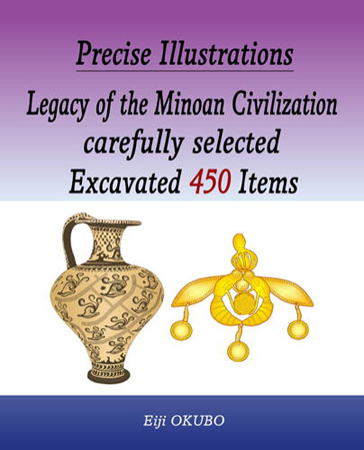 |
| subtitle: Touring to Minoan civilization with precise illustrations of excavated artefacts language: English format: Paperback printing paper: Non-glossy high-quality paper printing ink: High-saturation premium ink size: 8in.x10in. (203mm x 254mm) 726 pages, weight 3.8lb (1.7kg) sales: Amazon Network / Amazon.com / Amazon.co.uk |
| Sumary: This book is 8in. x 10in. (203mm x 254mm) version, 720 pages, a “Precise Illustrations & Data Book” of excavated main items from the prehistoric Minoan Civilization ruins in Crete, and some finds from mainland Greece and Santorini Island. This book is picking up carefully selected “Excavated 450 Items” unearthed in important large to small archaeological sites in Crete, including the Knossos Palace and surroundings ruins, where were the center of the Minoan Civilization. More than 90% of the excavated items in this book explained are depicted in Precise Illustrations, and the rest are shown in Photographs, and including Detailed data and Descriptions of each individual find, along with associated data on the sites where they were unearthed. This book will invite you to the “World of Crafts and Arts” of the Minoan Civilization through carefully selected important works from among the excavated items on display at the Heraklion Archaeological Museum and other museums in Crete, and the National Archaeological Museum of Athens. Contents: What is the Minoan Civilization? I Jewelry Goods I-1 Gold Signet Ring I-2 Necklace & Pendant I-3 Gold Cup I-4 Gold & Silver Jewelry and Stones II Fresco II-1 Limestone, Stucco/Plaster, Fresco techniques II-2 Minoan Fresco II-3 Fresco Geometric Pattern II-4 Fresco Expressing Persons II-5 Fresco Expressing Animals II-6 Fresco Floral Expressing III Pottery III-1 Early Minoan Pottery III-2 Middle Minoan Pottery, Kamares style III-3 Middle Minoan Pottery, General Purpose III-4 Late Minoan Pottery, Palace style III-5 Late Minoan Pottery, Marine Design style III-6 Late Minoan Pottery, Floral Design style III-7 Late Minoan Pottery, Abstract & Geometric III-8 Late Minoan Pottery, General Purpose III-9 Ritual Rhyton III-10 Pottery Rhyton for Decoration III-11 Pottery for Daily Life IV Seal and Clay Imprint IV-1 Stone Seal IV-2 Ivory & Bone Seals IV-3 Clay Imprint V Stone Working V-1 Rhyton for Decoration V-2 Ritual Rhyton V-3 Stone Figurine V-4 Stone Building Structure V-5 Lamp & Daily Goods VI Minoan & Mycenaean Linear & Hieroglyph VI-1 Linear A VI-2 Linear B VI-3 Hieroglyph & Special Sign VII Bronze Work VII-1 Bronze Adorned Sword & Weapon VII-2 Bronze Double Axe VII-3 Bronze Adorned Vessel VII-4 Bronze Figurine & Daily Life VIII Terracotta Figurine & Larnax Coffin VIII-1 Votive offerings, Terracotta Figurine VIII-2 Terracotta Larnax Coffin IX Ivory Work IX-1 Ivory Works IX-2 Animal Bone & Fang Works X Agriculture & Fishing & Everyday Life X-1 Agriculture & Breeding & Costal Fishing X-2 Everyday Life |
| Sample Page:(excerpt) ---------- I-1-02 Gold Signet Ring, “Gold Isopata Ring” 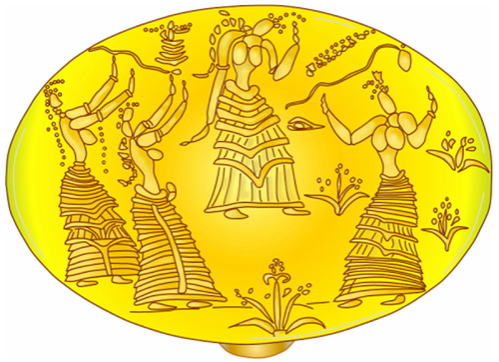 Site: Royal Tomb, Chamber Tomb 1, Isopata Shape & Decoration: Gold Signet Ring, oval-shaped seal face Epiphany: Goddess, two snakes, four dancing women, meadow with violets blooming Era: LMI, 1550-1450 BC Museum: HAM, inv. No. 424 / L26mm Local: Central North, Crete Drawing: Eiji OKUBO The Chamber Tomb 1 of the Royal Tomb at Isopata site, which has the long Dromos/Passage stretching more than 55m in the northward direction, and the sides of the burial Chamber room and the Fore room were perfectly constructed with exquisite masonry of cut stones and had the sturdy design. 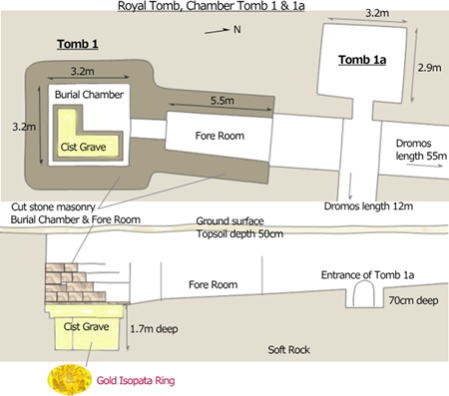 Site: Royal Tomb, Chamber Tomb 1 & 1a, Isopata Situation: Structural drawing, “Gold Isopata Ring” from cist grave in Chamber room Re. information: Papers, Sir Arthur John Evans “Archeology of other regions v. LXV” (1913) Era: LMII, 1450-1400 BC Local: Central North, Crete / 2.8km north from Knossos Palace Drawing: Eiji OKUBO GPS: 35°19'17''N 25°09'19''E / ALT 90m A cist grave approximately 1.7m deep was excavated in an L-shaped on the southeast floor of the square burial chamber, and a magnificent gold signet ring was unearthed from inside, depicting a scene of four Minoan women dancing while being watched by a goddess and two snakes. This is one of the greatest masterpieces of jewelry in Minoan craft art. The four women are wearing thick, Minoan-style skirts; the two on the left and the woman in the center are younger women as they have hair ornaments and swaying long hair, while the woman on the right has her hair tied up and is therefore probably a slightly older woman than the three. As violets are blooming all around the four, it is likely spring, and the location is the grassland such as Gypsades Hill south of the Palace of Knossos. The owner (death) of this gold signet ring was a Minoan queen, a beautiful princess, or a high-ranking aristocrat who lived in the Knossos Palace during the Minoan civilization's most peaceful and prosperous period. It is believed to have been made during the heyday of the “New Palace Era with dancing Flowers,” during the Late Minoan civilization LMIA to LMIB period, 1550 to 1450 BC. I-1-03 Gold Signet Ring of “Princess of Archanes” 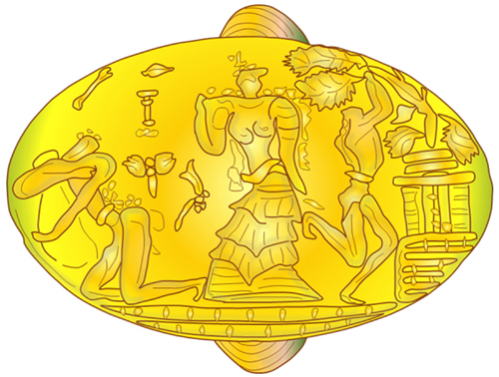 Site: Tholos Tomb A, Fourni Common Cemetery, Archanes (Tomb of Princess of Archanes) Shape & Decoration: Gold Signet Ring, oval-shaped seal face Epiphany: goddess, man with sacred stone “Baetylus,” man at shrine with sacred tree, butterfly Era: MMIIIB-LMIA, 1600-1500 BC Museum: HAM, inv. No. 989 / L26mm Local: Central North, Crete Drawing: Eiji OKUBO 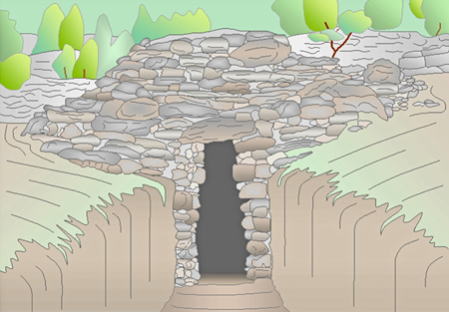 Site: Tholos Tomb A, Fourni Common Cemetery, Archanes so called “Tomb of Princess Archanes” Situation: view from Dromos length 18m to Tomb Entrance a) Tholos burial chamber inner diameter 4.5m with burial antechamber 2m square b) Tholos burial chamber floor=semi-underground type c) Tholos to Dromos=N90° (opening to East) Era: MMIIIB-LMIA, 1600-1500 BC Local: Central North, Crete / 7km south from Knossos Palace Drawing: Eiji OKUBO GPS: 35°14'42''N 25°09'32''E / ALT 430m A gold signet ring excavated from the Tholos Tomb A, believed to be the "Tomb of the Princess of Archanes" at the Archanes Fourni common cemetery, 7km south of the ruins of the Palace of Knossos, is oval in shape, 26mm wide, and a distinctive Epiphany expression. In the center of the seal stands a Minoan goddess wearing a distinctive thick skirt, and to her right is a temple-like building that appears to be a tripartite shrine with a sacred tree that curves upward, with an active young Minoan man carved into it, as if he is about to touch the branches to receive the blessings of the god. On the left side of the seal, on the other hand, there is a Minoan man kneeling at a sacred stone as if he is worshipping something, or perhaps holding a large funerary pithos, looking a little dejected. In the space between the goddess and the kneeling man there are two butterflies, and above the butterflies there are inscriptions that are thought to be from the Egyptian Pillar of Osiris, which represents the death and rebirth of plants, a view of life and death. Related: Goddess of Crafts and Epiphany expression A large number of craftworks with Goddess motifs have been excavated from building remains and tomb remains in both the Minoan and Mycenaean civilizations. The idea of worshiping the Goddess began in the Minoan civilization, which was strongly influenced by the Middle East and Egyptian civilizations, and was also frequently expressed in the crafts of the Mycenaean civilization on the Greek mainland, which was culturally and technologically influenced by the Minoan civilization. In terms of goddess motifs, many works have been found in both the Minoan and Mycenaean civilizations, including gold signet rings, stone seals, and clay imprints, and they were also expressed in frescoes. The form of expression of the goddess, there are few single depictions of the goddess, and most of them are centered around the goddess, with people and animals arranged around her, and scenes in which sacred griffins and sphinxes protect the goddess are particularly notable. In addition, in the Minoan civilization, goddesses are depicted in perspective in the distant (small size) parts of the work, watching over people's actions and behavior from the clouds or the heaven. Researchers call this pattern of goddesses protecting people Epiphany Expressions, and while it is the sacred and special scene, it is also considered to be something that can occur in everyday life. In the Minoan and Mycenaean civilizations, goddesses are not depicted in the special form, but in the same form as women of the slightly higher rank. However their costumes are special, and most goddesses wear each a long skirt with a slightly thick feel, which characterized by the layered V-pattern made of multiple pieces of fabric sewn together, which was first started in the world history of costumes by female Minoan artisans. Related: Mycenaean Crafts, Epiphany expression, Gold Signet Ring & Stone Seal  Site: Chamber Tomb 91, Panagia, Mycenae Shape & Decoration: Gold Signet Ring, arm (hoop)=granulation technique Epiphany: a goddess watching over, shrine with sacral tree, a man, a pleading woman Era: LHII-LHIIIA1, 1550-1375 BC Museum: NAM, inv. No. 3179 / L29mm Local: Argolis, Peloponnese Drawing: Eiji OKUBO 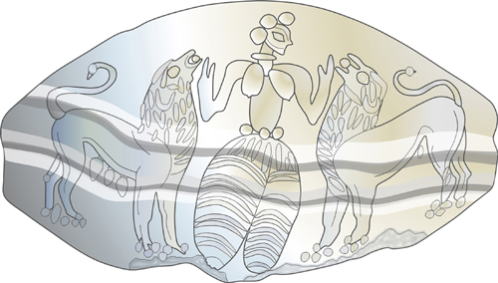 Site: Chamber Tomb, Mycenae Shape & Decoration: Agate Seal Epiphany: goddess and two obedient lions Era: LHII-LHIIIA1, 1500-1375 BC Museum: Ashmolean Museum, U. Oxford (UK), inv. No. 1938-1050 / L30mm Local: Argolis, Peloponnese Drawing: Eiji OKUBO I-2-06 Gold Pendant, so-called “Bee Pendant”  Site: Chrysolakkos Cemetery, Malia Palace Shape & Decoration: Gold Pendant, so-called “Bee Pendant” Gold granulation technique: two bees facing each other Era: MMIIA, 1800-1700 BC Museum: HAM, inv. No. 559 / H46mm Local: Central North, Crete Drawing: Eiji OKUBO The "Gold Bee Pendant," one of the finest gold jewelry pieces from the Minoan civilization, was excavated from the Malia Chrysolakkos Common Cemetery, 35km east of Heraklion, which is the royal burial facility of the Maria Palace and consists of numerous connected buildings, including the colonnaded structure. The gold pendant found in the 1921 excavation was made in the middle of the Old Palace Era, during the MMIIA period of the Middle Minoan civilization, 1800-1700 BC. The gold pendant, which depicts two bees facing each other, is decorated with intricate gold particles and countless beads (small spheres) on the wings, abdomen, around the eyes, and the collected pollen balls. This intricate jewelry technique is called the “Gold Granulation Technique,” which is said to have been developed by the Babylonian Sumerians in the Middle East 5,500 years ago. I-2-10 Necklace, Gold & Ivory beads and Green Jasper 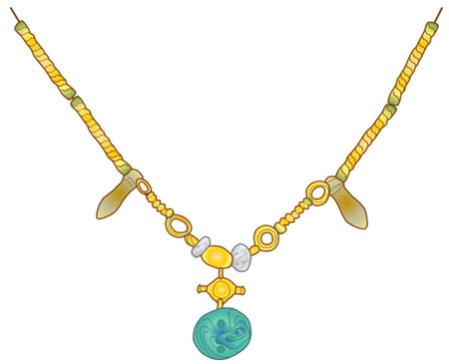 Site: Tholos Tomb Γ, Fourni Common Cemetery, Archanes Shape & Decoration: Gold and ivory beads Necklace, pendant top = green jasper Era: EMIII, 2200-2000 BC Museum: HAM Local: Central North, Crete Drawing: Eiji OKUBO II-4-14 Limestone Sarcophagus Fresco, “Funeral scene” 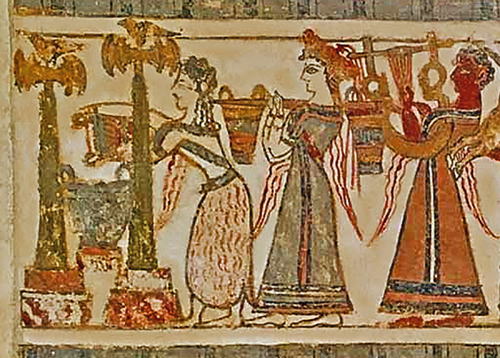 Site: Circular Tomb B, Agia Triada Shape & Decoration: Limestone Sarcophagus Fresco, “Funeral Scene” for male royal member Enlarge drawing=two large double axes with doves, sheepskin skirt female funeral staff pouring sacrificial bull blood by tilting vase, royal woman in a luxurious outfit with a tiara and hair ornament carrying two vessels with blood, long skirt musician playing 7-string lyre Era: LMIIIA2, 1375-1300 BC Museum: HAM, inv. No. 396 / L1,375mm Local: Messara Plain, Crete Photo: 1996 II-5-07 Fresco, “Blue Bird”  Site: House of the Fresco, Knossos Palace Shape & Decoration: Fresco “Blue Bird,” standing on the rocky place where flowers bloom Era: LMIA, 1550-1500 BC Museum: HAM / H60cm Local: Central North, Crete Drawing: Eiji OKUBO II-5-09 Fresco, “Wild Cat aiming for Pheasant” 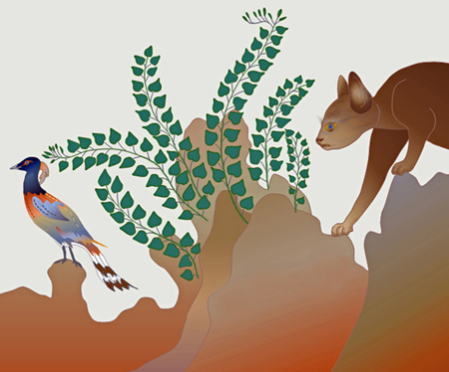 Site: Room of the Fresco, Quasi-palace quarter, Agia Triada Shape & Decoration: Fresco “Wild Cat aiming for pheasant” in rocky area with ivy Era: LMIA-LMIB, 1550-1450 BC Museum: HAM / L40cm, W40cm Local: Messara Plain, Crete Drawing: Eiji OKUBO III-1-01 Agios Onouphrios style Jug, Fine Line pattern 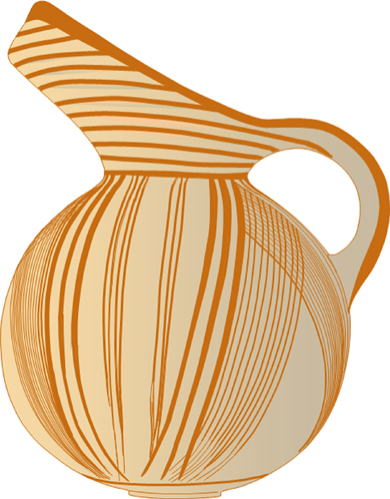 Site: Circular Tomb, Agios Onouphrios Shape & Decoration: Agios Onouphrios style Jug, elegant vessel shape, fine line pattern Era: EMI, 2700-2600 BC Museum: HAM, inv. No. 5 / H215mm Local: Messara Plain, Crete / 1km north-northwest from Phaestos Palace Drawing: Eiji OKUBO GPS: 35°03'33.50''N 24°48'26.50''E / ALT 35m About 1km north-northwest of the Phaestos Palace ruins and 40m northwest of the Chapel of Agios Onouphrios, which stands beside the main road N97, are the Messara style Circular Tomb in olive farmland. Excavations of the Tomb at the end of the 19th century uncovered stone vessels, jewelry, bronze dagger, stone seals, and the Aegean Cycladic style clay statue. An elegant Agios Onouphrios style jug from the Early Minoan civilization with a graceful shape and decoration of fine reddish-brown lines has also been found. II-2-09 Kamares style, Piriform Pithos Jar, “Fish” motif  Site: Room 64, “Prince’s Room,” East Wing, Phaestos Palace Shape & Decoration: Kamares style, Piriform Pithos Jar, fish, spiral line, and wavy patterns Era: MMIIB, 1700-1625 BC Museum: HAM, inv. No. 10679 / H495mm Local: Messara Plain, Crete Drawing: Eiji OKUBO 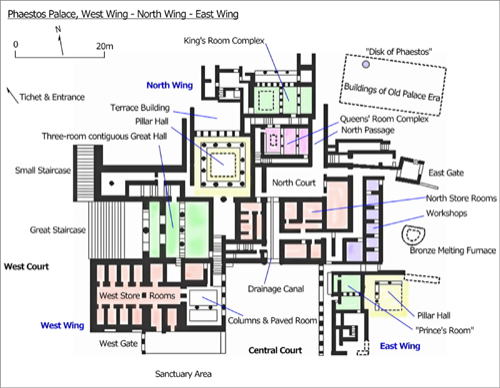 Site: Plan of West-North-East Wings, Phaestos Palace a) New Palace=MMIIIA-LMIB, 1625-1450 BC b) Old Palace=MMIB-MMIIB, 1900-1625 BC (partially) Local: Messara Plain, Crete Drawing: Eiji OKUBO III-7-02 Ephyrean style Goblet, “Curved Petal” motif 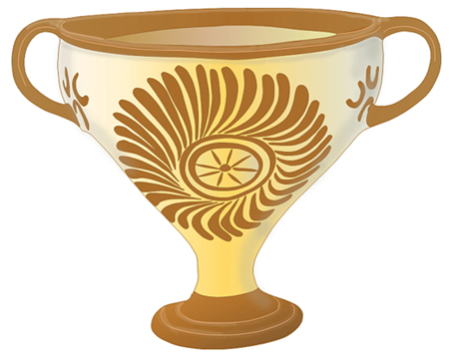 Site: Temple Tomb (Royal Tomb), Knossos Palace Shape & Decoration: Abstract and Geometric design, Ephyrean style Goblet, curved petal pattern Era: LMII, 1450-1400 BC Museum: HAM, inv. No. 9062 / H150mm Local: Central North, Crete / 630m south from Knossos Palace Drawing: Eiji OKUBO Several goblets have been excavated from the Temple Tomb on the eastern slope of the Gypsades Hill, south of the Knossos Palace ruins. One of the goblets from the Royal Tomb is slightly smaller than the goblet found at the mansion ruins near the Royal Road. This has the classic ring handle at the mouth/rim, and the body is boldly painted with the abstract flower, with the slender comma-like motif of rotating and curving petals. Additionally, three small U-shapes are depicted on the sides of the handle as an accent. IV-1-02 Carnelian Seal, “Lion attacking Bull” motif 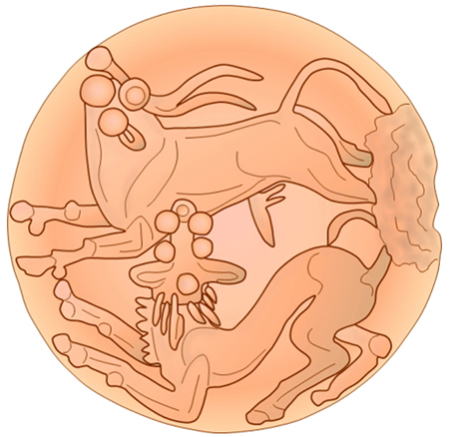 Site: Chamber Tomb 99, Common Cemetery, Zafer Papoura Shape & Decoration: circular lens-shaped Carnelian Seal, lion attacking bull Era: LMII, 1450-1400 BC Museum: HAM, inv. No. 687 / W18mm Local: Central North, Crete / 1km north from Knossos Palace Drawing: Eiji OKUBO GPS: 35°18'24''N 25°09'47''E / ALT 90m An excavation mission led by Sir Arthur John Evans identified over 100 tombs belonging to the Late Minoan civilization at the Common Cemetery at the Zafer Papoura site. The burial room of Chamber Tomb 99 is a square measuring 270cm on each side, and contains the remains of two adults with their heads facing west, and what appears to be a child, and it has been determined that the burials belonged to a family of three. A total of 19 items, probably for necklace beads, were found in the neck and chest area of the body believed to be a man, including a carnelian seal with a lion attacking a bull, an Egyptian scarab seal, and beads made of gold, ivory, crystal, steatite, and bronze. Related: African lion on the savanna grassland 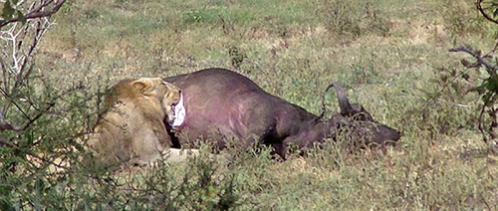 Female African lion preying on buffalo after attacking Local: Sabi River Basin, Kruger National Park, South Africa Photo: 2017 IV-3-01 Imprint, “Goat & Papyrus” motif  Site: Central Great Staircase, West Wing, Knossos Palace Shape & Decoration: Clay Imprint, six goats or mouflons sitting quietly stamped with hard stone seal? Era: LMIIIA1, ca. 1375 BC Museum: HAM, inv. No. 231 / L24mm Local: Central North, Crete Drawing: Eiji OKUBO V-1-01 Marble Rhyton, “S”-shaped handles 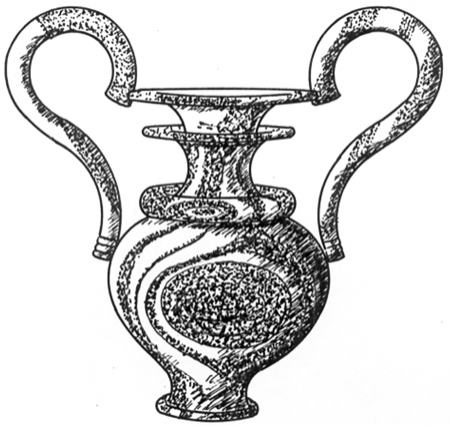 Site: Ritual Bath, West Wing, Zakros Palace Shape & Decoration: Marble decorative Rhyton with “S”-shaped handles Era: LMIB, 1500-1450 BC Museum: HAM, inv. No. 2720 / H405mm Local: Easternmost, Crete Drawing: Eiji OKUBO A ceremonial rhyton made of marble with a harmonious and extremely beautiful form was discovered in the Ritual Bath, an important facility in the West Wing of the easternmost Zakros Palace ruins. The entire rhyton is a clear milky white color mixed with flowing, curving pale green stripes, and the front of the body in particular is slightly reddish with swirling blue-green stripes. This type of overwhelmingly beautiful stone rhyton has not been found even in the ruins of the Knossos Palace, the center of civilization. V-2-01 Serpentine “Bull-head shaped Rhyton” The serpentine or steatite "Bull-head shaped Rhyton" was found in the Knossos Palace Area, 350m northwest of the Central Court, in a large and magnificent building ruins that researchers call the "Small Palace." In the Minoan civilization, the bull was a sacred symbol of power worshipped by the people, and various rhytons in the shape of bull's heads were used in religious ceremonies and rituals. In addition to stone bull-head shaped rhytons, many terracotta rhytons have also been excavated from Minoan civilization ruins. Bull-horn U-shaped objects were also used to decorate the entrances and roofs of palaces, and the exterior decorations of sacred buildings such as the Tripartite Shrine in the West Wing of the Knossos Palace. Small U-shaped objects were produced in a variety of types, including stone and terracotta. These small objects were not only displayed in the fine rooms of nobles, but also in the common shrines of prosperous towns and in the homes of ordinary people: as seen in the Inner Shrine attached to the Throne Room at the Knossos Palace ruins, the Sanctuary of the Zakros Palace in the easternmost part, and in large numbers excavated from the larger Minoan towns such as Gournia and Palaikastro. In addition, bulls and bull-leaping scenes were depicted in the carved designs of countless stone and gold seals, making the bull the most familiar and most important object of worship for the people of the Minoan Kingdom. 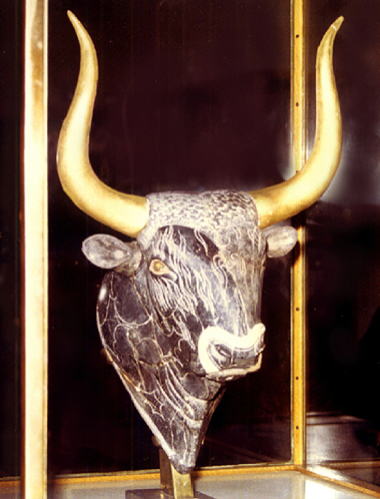 Site: Small Palace, Knossos Palace Shape & Decoration: Serpentine “Bull-head shaped Rhyton” Era: LMIB, 1500-1450 BC Museum: HAM, inv. No. 1368 / bull head excluding horns H206mm Local: Central North, Crete Photo: 1982 It can be understood by looking at the surface gloss of the actual Bull-head Rhyton excavated from the Knossos Small Palace, which is on display at the Heraklion Archaeological Museum HAM, that the left half (right on photo) of the head from the center is the real part from the Minoan Era, and the slightly shiny right half (left on photo) is the replica. The horns were, however, made of wood and corroded, so they were not found during the excavation. The bull's eyes are made of rock-crystal, the eyelashes are of jasper, the nose is inlaid with pearl oyster, and a small hole on the top is believed to have been used to pour the blood of the sacrificial bull during rituals. The rhyton is said to have been made during the heyday of the New Palace Era, during the Late Minoan LMIB period, 1500-1450 BC. The Bull-head shaped Rhyton, a cult statue of the "New Palace Era with Dancing Flowers," is one of the trademark treasures that are worthy of symbolizing the Minoan civilization. Mycenaean Linear B Clay Tablet from Knossos Palace 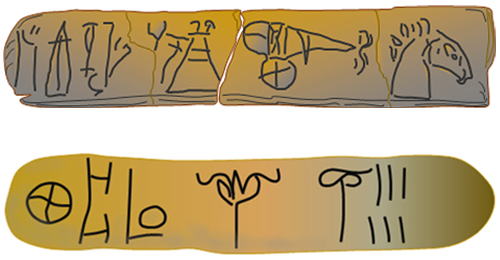 Site: Royal Sanctuary Area, West Wing, Knossos Palace Shape & Decoration: Mycenaean Linear B Clay Tablet, “Two-wheeled Chariot” Ideographic translation by Richard Vallane Janke (2016) = (Person’s name) in armor drives a two-wheeled chariot Era: LMIIIA1, ca. 1375 BC Museum: HAM, inv. No. 1609 / L100mm Local: Central North, Crete Drawing: Eiji OKUBO Site: Sanctuary Area, West Wing, Knossos Palace Shape & Decoration: Mycenaean Linear B Clay Tablet, “Saffron” a) Ideographic translation: "(three-letter personal name) - blooming saffron flower - quantity 6 units” b) Unit notation: 〇 100 units / a horizontal line 10 units / a vertical line 1 unit Era: LMIIIA1, ca. 1375 BC Museum: HAM Local: Central North, Crete Drawing: Eiji OKUBO VI-3-10 Terracotta “Phaestos Disk”  Site: Section of “Old Palace Era,” North Wing, Phaestos Palace Shape & Decoration: Terracotta so-called “Phaestos Disk” Era: MMIIB-MMIIIA, 1700-1600 BC Museum: HAM / D15.8cm-16.5cm Local: Messara Plain, Crete Photo: 1982 To the east of the Royal Family's Private section of the Phaestos Palace ruins, there is a series of relatively old buildings, probably the remains of workshops, dating back to the Old Palace Era of the Middle Minoan civilization MMII period or the beginning of the New Palace Era of the following the MMIIIA period. Ivory Log and fine produst "Bull leaper" Ivory, an extremely important raw material for the Minoan civilization along with copper ingots from Cyprus, was imported from the Middle East and Egypt, with most of it unloading ashore at Zakros Palace in the easternmost part of Crete. 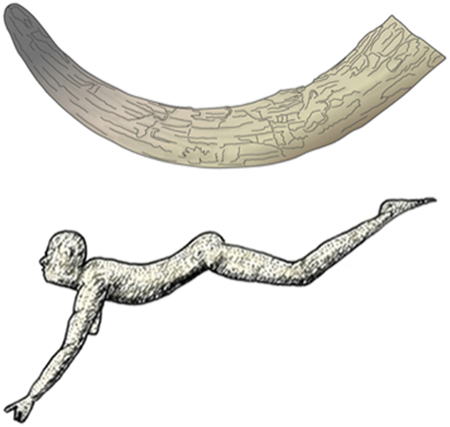 Site: West Wing, Zakros Palace Shape & Decoration: Imported Ivory Log from Middle East or Egypt Era: LMIB, 1500-1450 BC Museum: HAM Local: Easternmost, Crete / 19km southeast from Sitia city Drawing: Eiji OKUBO GPS: 35°05'53''N 26°15'40''E / ALT 5m Site: "Daemon Seal Area," East Wing, Knossos Palace Shape & Decoration: Ivory Statue, “Bull leaper” or “Bull leaping man” Era: MMIIB, 1700-1600 BC Museum: HAM, inv. No. 3 / from left hand to toe 245mm Local: Central North, Crete Drawing: Eiji OKUBO The ivory Bull leaper/Bull leaping man is one of the pieces that date back to a somewhat earlier period than many of the other artifacts found at the Knossos Palace ruins, dating back to the Middle Minoan civilization MMIIB period, around 1700 to 1600 BC, the latter half of the Old Palace Era. ---------- |